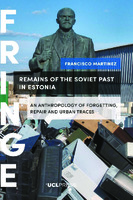Remains of the Soviet Past in Estonia
| dc.contributor.author | Martinez, Francisco | |
| dc.date.accessioned | 2018-08-01 23:55 | |
| dc.date.accessioned | 2019-01-11 13:45:08 | |
| dc.date.accessioned | 2020-04-01T12:32:54Z | |
| dc.date.available | 2020-04-01T12:32:54Z | |
| dc.date.issued | 2018 | |
| dc.identifier | 1000353 | |
| dc.identifier | OCN: 1051775708 | en_US |
| dc.identifier.uri | http://library.oapen.org/handle/20.500.12657/29579 | |
| dc.description.abstract | What happens to legacies that do not find any continuation? In Estonia, a new generation that does not remember the socialist era and is open to global influences has grown up. As a result, the impact of the Soviet memory in people’s conventional values is losing its effective power, opening new opportunities for repair and revaluation of the past. Francisco Martinez brings together a number of sites of interest to explore the vanquishing of the Soviet legacy in Estonia: the railway bazaar in Tallinn where concepts such as ‘market’ and ‘employment’ take on distinctly different meanings from their Western use; Linnahall, a grandiose venue, whose Soviet heritage now poses diffi cult questions of how to present the building’s history; Tallinn’s cityscape, where the social, spatial and temporal co-evolution of the city can be viewed and debated; Narva, a city that marks the border between the Russian Federation, NATO and the European Union, and represents a place of continual negotiation of belonging; and the new Estonian National Museum in Raadi, an area on the outskirts of Tartu, that has been turned into a memory field. | |
| dc.language | English | |
| dc.relation.ispartofseries | Fringe | |
| dc.subject.classification | thema EDItEUR::N History and Archaeology::NH History::NHD European history | en_US |
| dc.subject.classification | thema EDItEUR::J Society and Social Sciences::JH Sociology and anthropology | en_US |
| dc.subject.classification | thema EDItEUR::J Society and Social Sciences::JH Sociology and anthropology::JHM Anthropology | en_US |
| dc.subject.classification | thema EDItEUR::J Society and Social Sciences::JH Sociology and anthropology::JHM Anthropology::JHMC Social and cultural anthropology | en_US |
| dc.subject.classification | thema EDItEUR::J Society and Social Sciences::JP Politics and government::JPF Political ideologies and movements::JPFC Far-left political ideologies and movements | en_US |
| dc.subject.other | Estonia | |
| dc.subject.other | Communism | |
| dc.subject.other | Eastern Europe | |
| dc.subject.other | Soviet | |
| dc.subject.other | Linnahall | |
| dc.subject.other | Narva | |
| dc.subject.other | Russians | |
| dc.subject.other | Tallinn | |
| dc.title | Remains of the Soviet Past in Estonia | |
| dc.type | book | |
| oapen.identifier.doi | 10.14324/111.9781787353534 | |
| oapen.relation.isPublishedBy | df73bf94-b818-494c-a8dd-6775b0573bc2 | |
| oapen.relation.isbn | 9781787353534 | |
| oapen.pages | 282 | |
| oapen.remark.public | Relevant Wikipedia pages: Estonia - https://en.wikipedia.org/wiki/Estonia; Estonian language - https://en.wikipedia.org/wiki/Estonian_language; Estonians - https://en.wikipedia.org/wiki/Estonians; Linnahall - https://en.wikipedia.org/wiki/Linnahall; Narva - https://en.wikipedia.org/wiki/Narva; Russians - https://en.wikipedia.org/wiki/Russians; Soviet Union - https://en.wikipedia.org/wiki/Soviet_Union; Tallinn - https://en.wikipedia.org/wiki/Tallinn | |
| oapen.identifier.ocn | 1051775708 |

